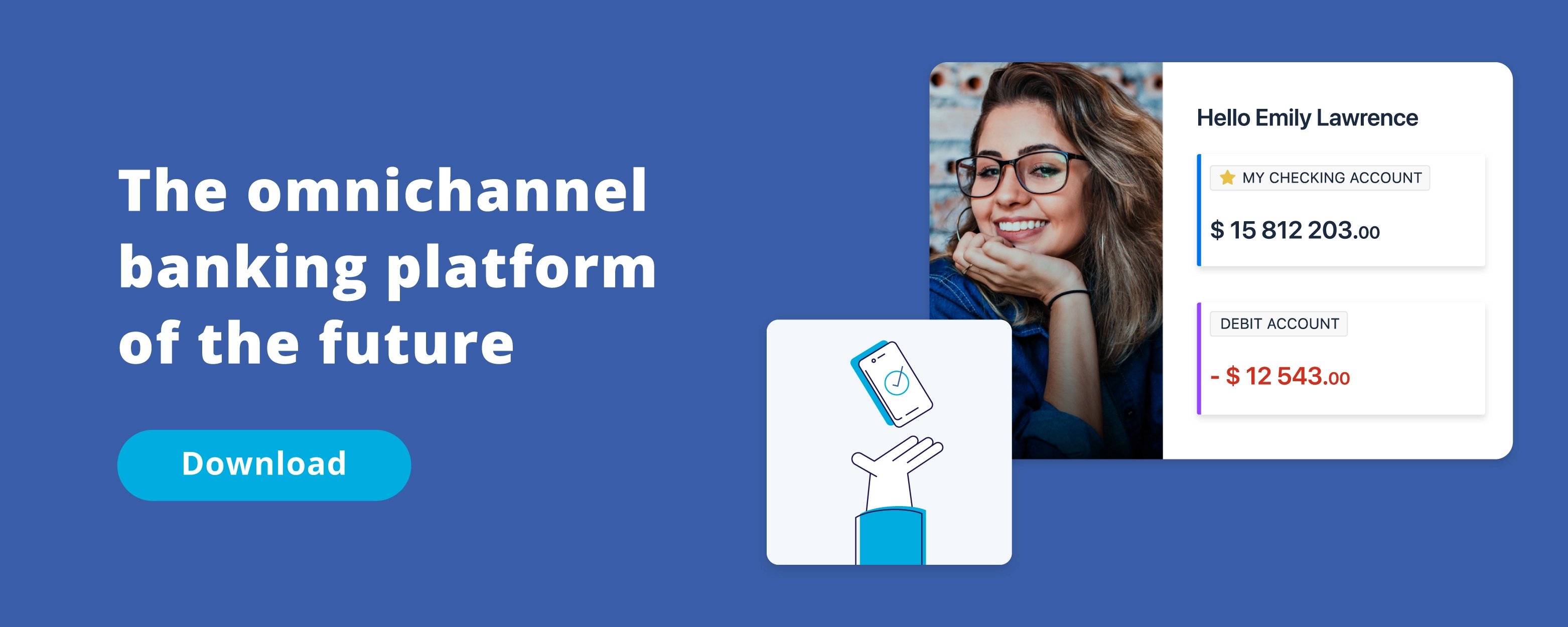The opportunity in delivering engaging digital services for US Financial Institutions
Adapting to consumers’ ever-changing needs and staying current with rapidly shifting market trends can be a challenge for US financial institutions, especially since customer engagement plays a pivotal role in their success, directly impacting satisfaction, loyalty, and overall business performance.
However, delivering a more personalized banking experience can be a great challenge due to restricted access to data, disparate systems, and antiquated or legacy technology, which can result in strategic limitations.
For US financial institutions to meet continually evolving consumer expectations, it will be important to look outside the financial services industry at market-leading organizations that have been successful in driving digital engagement, which are ultimately forming consuming expectations of the digital channel, such as Amazon, Netflix, or Uber.
Legacy technology across a financial institution is often the root of the challenge, preventing US financial institutions from keeping pace with rapid technological advancements and consumer expectations. While these technological solutions may have lower direct operating costs, they have resulted in increased costs to support, develop new capabilities, or implement third-party integrations.
The downstream effects ultimately result in a lack of innovation to deliver compelling digital services to existing and new customers or reduce operational costs through the use of modern automation and workflows while mitigating risk and maintaining compliance requirements.
In order to stay competitive in the ever-changing financial landscape, it is necessary for US financial institutions to confront these challenges and invest in modernizing their technology infrastructure. This strategic move will not only enhance customer experiences and boost efficiency but also maximize IT investments, coupled with leveraging the most current security and fraud prevention tools.
Ultimately, the market leaders will be established based on their ability to enhance customer engagement through a more personalized experience. By delivering a personalized experience, the account holder feels known by their financial institution.
A sense of feeling known leads to trust, fostering loyalty, which ultimately opens the door to new business opportunities. This all starts by modernizing technology and tapping into the potential of data, automation, AI, and machine learning applications.
Transforming digital banking in the US: key solutions to improve user engagement
In today's digital era, banking customers are no longer satisfied with simple online transactions and static bank interfaces. They now crave personalized, seamless, and human-centered experiences that align with their individual needs and preferences.
Meeting these expectations requires banks to innovate and adopt new strategies that go beyond traditional banking services. This is where a composable omnichannel solution, humanizing digital channel services, embedded finance, and hyper-personalization come into play.
These cutting-edge solutions enhance user engagement and redefine the way banks interact with their customers, creating a more engaging and fulfilling experience for US banking users.
1. A composable omnichannel solution
In the rapidly evolving financial landscape, financial institutions face increasing pressure to innovate and enhance their digital offerings. A composable omnichannel solution has emerged as a powerful approach to meet these demands. This flexible, modular system allows institutions to easily build and adapt their digital platforms, integrating various channels and services to deliver a seamless customer experience.
The benefits of implementing such a solution can create business impact in the areas of reduced operational costs, improved operational efficiency, digital differentiation, and enhanced customer acquisition.
A composable omnichannel approach, however, leverages modern, cloud-based technologies that reduce the need for extensive physical infrastructure and associated costs. By adopting a modular architecture, financial institutions can implement and scale new services more cost-effectively.
This means they can add or remove functionalities as needed without overhauling the entire system, leading to more efficient resource use and lower overall expenditures.
For community financial institutions, embracing digital transformation demands a fresh perspective centered on continuous innovation to stay ahead in the competitive landscape.
Through strategic partnerships with fintech firms and forward-thinking technology providers, these institutions can swiftly introduce cutting-edge products and services to market, captivating existing customers with novel offerings and fostering unwavering loyalty.
With ebankIT, banks can access a state-of-the-art digital omnichannel platform that seamlessly integrates with their core banking system, along with best-in-class fintechs, providing unmatched scalability and ease of implementation right from the start.
ebankIT enables financial institutions to execute their strategy through technology versus the traditional approach, where technology can constrain the strategy.
2. Humanized digital channel services
Humanized digital channel services leverage cutting-edge technology to provide an unparalleled customer engagement experience within the banking industry. By mirroring the personalized and empathetic interactions typically found in face-to-face meetings, these services can cultivate a relationship with customers, enhancing the overall connection. Strong and effective technology should create a more personalized experience, as opposed to a robotic feel.
By integrating features like conversational interfaces (such as chatbots), personalized recommendations, and user-friendly interfaces, banks can craft a digital experience that resonates with each customer's unique preferences and needs. This tailored approach not only boosts customer satisfaction but also fosters stronger levels of loyalty.
Successful humanized digital services showcase empathy and comprehension toward customers' needs and worries. For instance, chatbots with natural language processing abilities can engage in compassionate conversations, offering support and direction in a genuine and caring manner. This ability to forge an emotional bond with customers fosters deeper connections, instills trust, and allows banking personnel to concentrate on more intricate responsibilities.
By leveraging predictive analytics, humanized digital channel services have the capability to foresee customer needs and proactively offer tailored assistance. This proactive approach allows banks to identify potential issues or opportunities and provide customers with pertinent recommendations or solutions. By addressing customer needs in advance, banks showcase their dedication to delivering exceptional service and support.
3. Embedded Finance
Embedded finance seamlessly integrates additional financial services into transaction processes, offering personalized options like buy-now-pay-later, customized product insurance, and tailored financing offers based on individual profiles.
This heightened level of customization simplifies purchase decisions and boosts customer engagement, enhancing the overall digital banking experience. It integrates financial services into non-financial platforms, enhancing digital customer engagement by offering a wider range of services without the need for new accounts.
With the growing preference for embedded channels like digital platforms and marketplaces for financial transactions, market-leading financial institutions will embrace this trend to avoid losing customers.
This shift from traditional banking channels highlights the need for financial institutions to adapt and engage with customers through these innovative channels. Embracing embedded finance allows banks to connect seamlessly with customers, address their real-time needs, and reduce turnover.
Furthermore, embedded finance empowers financial institutions to broaden their outreach and connect with untapped customer segments through strategic partnerships with non-financial platforms and companies. This collaborative approach enables banks to reach customers wherever they are, eliminating the need for customers to come to them. This reach expansion can lead to increased market share and growth opportunities for financial institutions.
By leveraging embedded finance, financial institutions can improve the customer experience, increase sales and revenue, engage customers through embedded channels, offer tailored financial services, and expand their reach and market share.
4. Hyper-Personalization
Personalization has emerged as a crucial factor in the banking sector, serving as a key competitive advantage in the financial services industry. Financial institutions that excel in delivering a seamless, integrated, and all-encompassing customer experience are well-positioned for success.
Studies conducted by Genesys have shown that in times of financial turmoil, there is a significant surge in the demand for personalized services. In fact, a staggering 72% of Customer Experience Leaders have acknowledged this growing trend. This emphasizes the critical importance of tailored financial experiences during uncertain economic circumstances, as customers expect banks to leverage their data to streamline and enhance their banking journey.
Additionally, 60% of banks expressed concerns that a downturn could impede their digital expansion, prompting an urgent need to revamp their strategies. Here are the key focal points that banks should prioritize in order to elevate personalized services.
1. Customer satisfaction: It will be fundamental for financial institutions to reframe their personalization efforts by focusing on customer satisfaction in real-time rather than just click rates and conversions.
2. Using customer data: Leveraging customer data is key to understand banking customers better and provide personalized offers, educational content, and advice.
3. Offer relevant content: Crafting personalized content that seamlessly weaves customized experiences into the customer's journey at the perfect moment and location is essential.
4. Customer-centric: Market-leading financial institutions will shift from a traditional product-centric approach to a customer-centric approach that focuses on delivering unique and contextual journeys to keep customers engaged.
Revolutionize customer engagement with ebankIT
To effectively implement these advanced strategies, US financial institutions will require a robust and flexible digital platform that is beyond banking. This is where ebankIT shines as the premier choice for an out-of-the-box solution.
ebankIT offers a comprehensive suite of functionalities that can be quickly deployed to meet immediate needs while also allowing for extensive scalability and customization.
By opting for a hybrid approach with ebankIT, banks can combine the best of both buying and building strategies. This approach supports the implementation of a composable architecture, where different modules can be easily integrated and customized as needed.
Furthermore, ebankIT's API gateway facilitates seamless connectivity with other systems and best-in-class fintechs, ensuring that banks can continually adapt and innovate in response to changing consumer demands.
One of the standout benefits of using ebankIT is its ability to foster a culture of continuous innovation. With its modular design and open architecture, banks can incrementally add new features and functionalities without disrupting existing services.
This flexibility ensures that banks can stay ahead of the curve, offering their customers the latest advancements in digital banking and embedded finance capabilities.
ebankIT offers the essential tools and framework to seamlessly embed financial services, deliver personalized experiences through cutting-edge analytics, and enhance the human element in digital interactions, setting the stage for unparalleled success.
This approach not only leads to reduced operational costs and improved operational efficiencies but also facilitates digital differentiation. Building customer trust through the digital channel will open the door to new business opportunities along with creating a strong first impression with new customers.
In addition, financial institution customers are hyper-sensitive to privacy & security; financial institutions must clearly outline and showcase their security practices.
A robust technology strategy must empower a heightened level of personalization, not diminish it. ebankIT empowers financial institutions to provide a personalized and captivating digital experience by leveraging data, seamless integrations, and customer-centric options.
Financial institutions have the freedom to uphold their independence by tailoring and strategically adapting the digital platform to meet their changing requirements.
This flexibility streamlines the customization process, enabling swift integration of new third parties, the introduction of innovative widgets and modules, and the development of a unique UI design that truly reflects the essence of the financial institution.
By successfully implementing these strategies, financial institutions will differentiate themselves through the digital channel and be in control of their digital destiny.







%20without%20SAM%20-%20Maturity%20Level%20-%202-KO%20edit.webp?width=160&height=57&name=67768-ebankIT%20Platform%20-%20CMMI%20Development%20V2.0%20(CMMI-DEV)%20without%20SAM%20-%20Maturity%20Level%20-%202-KO%20edit.webp)
